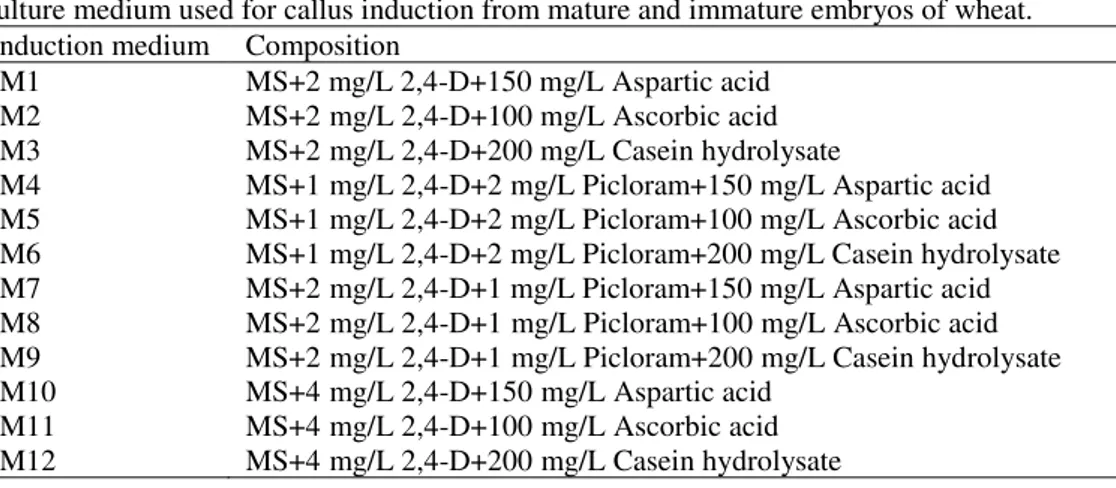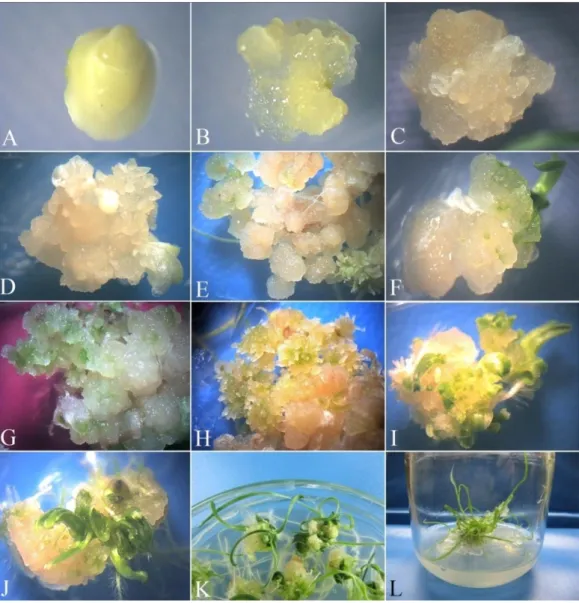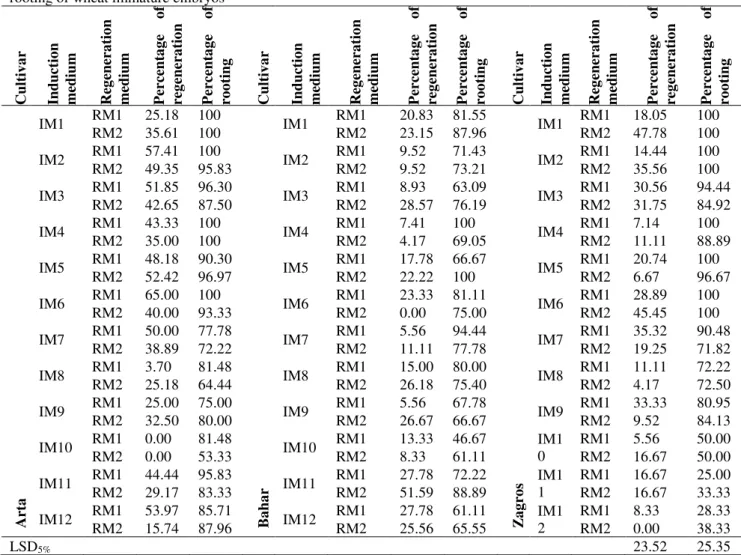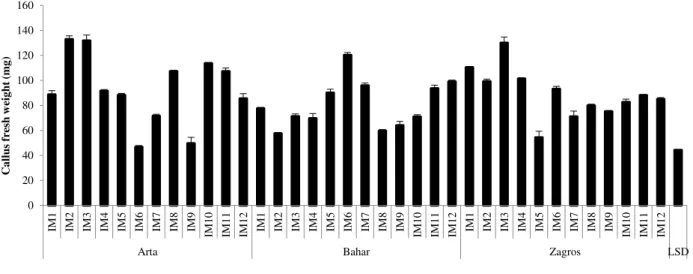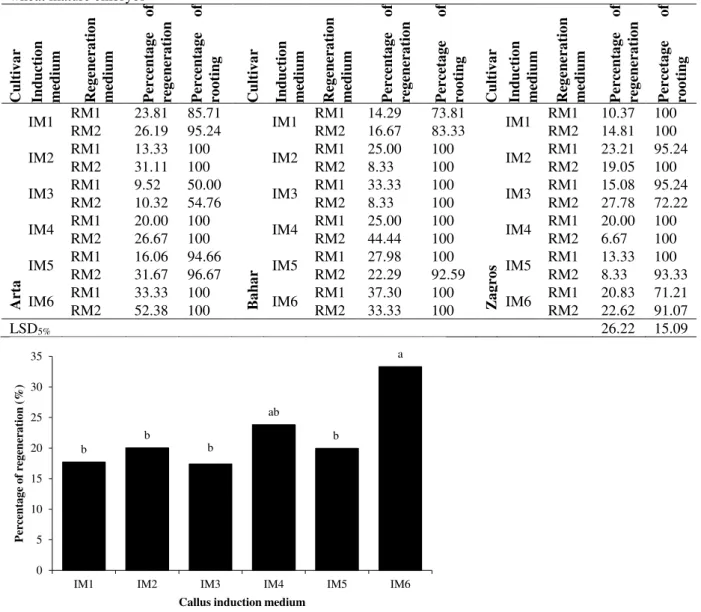Braz. Arch. Biol. Technol. v.59: e160288 Jan/Dec 2016
BRAZILIAN ARCHIVES OF BIOLOGY AND TECHNOLOGY
A N I N T E R N A T I O N A L J O U R N A L
Efficient
In Vitro
Somatic Embryogenesis and Plant
Regeneration from Mature and Immature Embryos of
Wheat (
Triticum aestivum
L.)
Roghayeh Ahmadpour
1, Nasser Zare
1,*,Rasool Asghari-Zakarta
1, Parisa Sheikhzadeh
1.
1Department of Agronomy and Plant Breeding, Faculty of Agriculture, University of Mohaghegh Ardabili, Ardabil,
Iran.
ABSTRACT
An efficient regeneration system is a pre-requisite for the application of genetic transformation and functional genomics study of important plants. In this study, the effect of different factors (plant growth regulators, casein hydrolysate, aspartic acid and ascorbic acid) on in vitro embryogenesis and regeneration of Arta, Bahar and Zagros cultivars from mature and immature explants were investigated. Immature and mature embryos were dissected from disinfected seeds 20-25 days after pollination and imbedded mature seeds, respectively, and cultured on MS (Murashige and Skoog) medium supplemented with different compounds. The results showed that immature embryos expose high capacity of embryogenesis and regeneration in comparison with mature embryos. There were significant differences between cultivars in terms of the percentage of callus induction and regeneration. Plant growth regulators had significant effect on percentage of callus induction in mature explants and percentage of regeneration from both explants. In immature explants, the highest percentage of regeneration (65%) was achieved with the Arta cultivar calli derived from MS medium supplemented with 1mg/L 2,4-D, 2mg/L Picloram and 200 mg/L casein hydrolysate, and subcultured on MS medium. Also, the highest percentage of regeneration (52.38%) from mature embryo explants was achieved in the Arta cultivar with callus induction on MS medium supplemented with 1 mg/L 2,4-D, 2 mg/L Picloram and 200 mg/L casein hydrolysate and regeneration on MS medium containing 0.05 mg/L NAA.
Key words: In vitro culture, Plant growth regulators, Somatic embryogenesis, Wheat
*Author for correspondence: zarenasser@yahoo.com, nzare@uma.ac.ir http://dx.doi.org/1678-4324-201616028
INTRODUCTION
Wheat is one of the most important cereals. It cultivates on approximately 17% of the cultivatable lands and plays a key role in economic development, food security and supply, human nutrition and is an important source of calories and proteins for human [1]. While, genetic engineering of wheat provides an efficient strategy for improvement of agronomic traits such as quality and disease resistance, but the graminaceous species are recalcitrant to in vitro regeneration and manipulations [2, 3]. An efficient regeneration system is the main pre-requisite for the application of genetic transformation and functional genomics studies in the primomovente of important plants [4]. Somatic embryogenesis is also an important step in transformation, regeneration and rapid large scale production of healthy true-to-type plants [1, 5]. Somatic embryogenesis provide a perfect system for plant regeneration because embryogenic calli can be maintained for a long time and supply high multiplication rates [6]. Wheat is a hexaploid plant with a large genome, high copy number of DNA repeat sequences, low in vitro regeneration capability and difficult transformation features [7]. Therefore, one of the main limiting factors for application of biotechnological techniques in the genetic improvement of wheat is the lack of an efficient in vitro regeneration system for broad range of cultivars and genotypes [3]. On the other hand, establishment of an efficient regeneration system is necessary for the genetic engineering of wheat.
The explants source, genotype and medium composition were shown to influence the frequency of callus induction and regeneration in the wheat tissue culture [8-11]. In particular, genotype and explants type are important factors for embryogenic callus production and regeneration [12]. The studies showed that, the successful in vitro regeneration of wheat plantlets is possible from different explants such as immature embryos, mature embryos, inflorescences, anthers, and microspores [13-15]. Immature embryos were used in several regeneration and transformation studies and it has better regeneration potential than the other explants such as inflorescence, mature embryo and apical meristem [16]. But the production of immature embryo is limited by environmental conditions such as light, temperature, water, diseases, pests, growth periods and etc. The use of mature embryo has several advantages including easy handling, no time limitation and its availability in large scale [3]. Therefore, mature embryos suggested as a suitable explants for in vitro regeneration and genetic manipulation of cereals. [4]. Medium compositions such as plant growth regulators are important factors affecting callus induction and in vitro regeneration. The auxin 2,4-D (2,4-Dichlorophenoxyacetic acid) is commonly used for callus induction in cereals as well as wheat [7, 17]. The aim of this study was optimization
of in vitro regeneration of Iranian different wheat cultivars using immature and
mature embryos. Therefore, the effect of different plant growth regulators on callus induction, somatic embryogenesis and plant regeneration from three wheat cultivars were investigated.
MATERIALS AND METHODS
Plant materials
Braz. Arch. Biol. Technol. v.59: e16160288 Jan/Dec 2016
water. Immature embryos were excised from sterilized immature seeds and cultured on medium.
For mature embryo explants preparation, the mature seeds of wheat were surface sterilized with 70% (v/v) ethanol for 3 min, 2% (w/v) sodium hypochlorite for 20 min and rinsed three times with sterile distillated water. The seeds were soaked with sterile distillated water overnight at 25°C in the dark and then, mature embryos were excised and cultured on medium.
Embryogenic callus induction
In order to embyogenic callus induction, the immature and mature embryos were cultured scutellum up on MS (Murashige and Skoog) medium supplemented with different concentrations of 2,4-D, Picloram, and organic additives such as casein hydrolysate, aspartic acid and ascorbic acid (Table 1). Twenty five embryos were cultured in each Petri-dish. The cultures were maintained in a growth chamber at 25
± 2 ˚C and dark for three weeks. Then, the percentage of callus induction,
embryogenic callus and callus fresh weights were recorded.
Table 1. Culture medium used for callus induction from mature and immature embryos of wheat.
Induction medium Composition
IM1 MS+2 mg/L 2,4-D+150 mg/L Aspartic acid IM2 MS+2mg/L 2,4-D+100 mg/L Ascorbic acid IM3 MS+2 mg/L 2,4-D+200 mg/L Casein hydrolysate
IM4 MS+1 mg/L 2,4-D+2 mg/L Picloram+150 mg/L Aspartic acid IM5 MS+1 mg/L 2,4-D+2 mg/L Picloram+100 mg/L Ascorbic acid IM6 MS+1mg/L 2,4-D+2 mg/L Picloram+200 mg/L Casein hydrolysate IM7 MS+2 mg/L 2,4-D+1 mg/L Picloram+150 mg/L Aspartic acid IM8 MS+2 mg/L 2,4-D+1 mg/L Picloram+100 mg/L Ascorbic acid IM9 MS+2 mg/L 2,4-D+1 mg/L Picloram+200 mg/L Casein hydrolysate IM10 MS+4 mg/L 2,4-D+150 mg/L Aspartic acid
IM11 MS+4 mg/L 2,4-D+100 mg/L Ascorbic acid IM12 MS+4 mg/L 2,4-D+200 mg/L Casein hydrolysate
Plant regeneration
After 3 weeks, the calli obtained from immature and mature embryos were sub-cultured on regeneration medium. The regeneration medium consisted of MS medium without hormone (RM1, Table 1) and supplemented with 0.05 mg/L NAA (Naphthalene acetic acid) (RM2, table 1). The cultures were maintained in a growth
chamber at 25 ± 2 ˚C and 16 h photoperiods. Percentage of rooting and regeneration
of plantlets were recorded after three weeks after culture. For further growth, the regenerated plantlets were transferred to MS medium for three weeks and then to pots containing sterilized Peat Moss, and were kept in a high humidity conditions under plastic bags for adaptation. In all cases, the pH of medium was adjusted to 5.8, solidified with 8 g/L plant agar and autoclaved at 121.5 °C for 15 min. The explants and calli were cultured on 30 ml of medium in 100 × 25 mm Petri plates and wrapped with Parafilm.
Experimental design and data analysis
All experiments were performed as factorial experiment based on completely randomized design (CRD) with three replications and 25 explants per replicate. Data analyses were performed using IBM SPSS Statistics (Version 22.0 (Armonk, NY, USA)). Mean comparisons were carried out using Least Significant Difference
RESULTS
Callus induction from immature embryo explants
Callus induction response was quick, so that most of the explants exhibited rapid swelling and cell proliferation 3-4 days after culture leading to the formation of friable embryogenic yellow callus within 1-2 weeks (Fig. 1C). Analysis of variance (ANOVA) indicated that there was significant differences (p<0.01) between the wheat cultivars in percentage of callus induction. But callus induction medium and its interaction with cultivar did not show significant effects on the percentage of callus induction. All of the tested cultivars displayed a high percentage of callus induction (97.58-100%) 21 days after culture. The Zagros cultivar showed an excellent (100%) callus induction frequency (Fig. 2A).
Callus fresh weight was significantly influenced by interaction of callus induction medium and cultivar, while medium and cultivar did not show significant effect on this trait. The mean of callus fresh weight ranged from 46.64 to 132.89 mg per callus. The highest amount of callus fresh weight (132.89 mg) was achieved with Arta cultivar on MS medium supplemented with 2 mg/L 2,4-D and 200 mg/L casein hydrolysate (Fig. 3).
Plant regeneration from immature embryo explants
About 3 weeks after culture of immature embryos, the calli were transferred to the regeneration medium. According to the ANOVA results, the percentage of embryogenic callus was significantly influenced by different callus induction medium and their interaction with cultivars. While it not influenced by cultivars, regeneration medium and their interactions. Among different callus induction medium, the highest percentage of embryogenesis achieved from the calli derived from the IM7, IM9 and IM12 media (Table 1 and Fig. 2B).
Different stages of somatic embryogenesis and plantlet regeneration were shown in fig. 1. The results indicated that the percentage of rooting were significantly (p<0.01) affected by cultivar, callus induction medium and their interaction. But there were no significant differences between different regeneration media. The percentage of rooting in the Arta cultivar (87.45%) was significantly higher than that of the Bahar and Zagros cultivars. In addition, the highest percentage of rooting in the Arta cultivar was obtained with IM1 and IM4; with IM7 in the Bahar cultivar and with IM1, IM2 and IM6 in the Zagros cultivar (Table 2). Therefore, in the Arta and Bahar cultivars the combination of low concentrations of 2,4-D with aspartic acid were more effective on rooting as compared with their combinations with ascorbic acid and casein hydrolysate.
Braz. Arch. Biol. Technol. v.59: e16160288 Jan/Dec 2016
Figure 1. Different stages of somatic embryo induction and development from immature embryos of wheat. A)
Immature embryo, B) Callus formation 3-4 days after culture on callus induction medium, C) Embryogenic callus, D,E,F) Different stages of somatic embryo development, G, H, I) Different stages of rooting and initiation of shoot formation, J, K) Plantlets regeneration 2 and 3 weeks after transferring to regeneration medium, L) Regenerated plantlet on MS medium
Figure 2. A) Percentage of callus induction from immature embryos of different wheat cultivars. B) Effect of
different callus induction medium on percentage of embryogenesis from immature embryos of wheat
b b
a
96 96,5 97 97,5 98 98,5 99 99,5 100 100,5
Arta Bahar Zagros
P
ercen
ta
g
e
o
f
ca
ll
u
s
in
du
cti
o
n
(%
)
Cultivars
A
bc abc abc
a ab ab
a
ab a
c
a a
84 86 88 90 92 94 96 98 100 102
IM1 IM2 IM3 IM4 IM5 IM6 IM7 IM8 IM9 IM10IM11IM12
P
e
r
c
e
n
ta
g
e
o
f
e
m
b
r
y
o
g
e
n
e
si
s
(%
)
Table 2. The effect of different cultivars, callus induction and regeneration medium on plantlet regeneration and rooting of wheat immature embryos
Cultiv a r Ind uct io n mediu m Reg ener a tio n mediu m P er ce nta g e o f re g ener a tio n P er ce nta g e o f ro o ting Cultiv a r Ind uct io n mediu m Reg ener a tio n mediu m P er ce nta g e o f re g ener a tio n P er ce nta g e o f ro o ting Cultiv a r Ind uct io n mediu m Reg ener a tio n mediu m P er ce nta g e o f re g ener a tio n P er ce nta g e o f ro o ting Art a
IM1 RM1 25.18 100
B
a
ha
r
IM1 RM1 20.83 81.55
Z
a
g
ro
s
IM1 RM1 18.05 100
RM2 35.61 100 RM2 23.15 87.96 RM2 47.78 100
IM2 RM1 57.41 100 IM2 RM1 9.52 71.43 IM2 RM1 14.44 100
RM2 49.35 95.83 RM2 9.52 73.21 RM2 35.56 100
IM3 RM1 51.85 96.30 IM3 RM1 8.93 63.09 IM3 RM1 30.56 94.44
RM2 42.65 87.50 RM2 28.57 76.19 RM2 31.75 84.92
IM4 RM1 43.33 100 IM4 RM1 7.41 100 IM4 RM1 7.14 100
RM2 35.00 100 RM2 4.17 69.05 RM2 11.11 88.89
IM5 RM1 48.18 90.30 IM5 RM1 17.78 66.67 IM5 RM1 20.74 100
RM2 52.42 96.97 RM2 22.22 100 RM2 6.67 96.67
IM6 RM1 65.00 100 IM6 RM1 23.33 81.11 IM6 RM1 28.89 100
RM2 40.00 93.33 RM2 0.00 75.00 RM2 45.45 100
IM7 RM1 50.00 77.78 IM7 RM1 5.56 94.44 IM7 RM1 35.32 90.48
RM2 38.89 72.22 RM2 11.11 77.78 RM2 19.25 71.82
IM8 RM1 3.70 81.48 IM8 RM1 15.00 80.00 IM8 RM1 11.11 72.22
RM2 25.18 64.44 RM2 26.18 75.40 RM2 4.17 72.50
IM9 RM1 25.00 75.00 IM9 RM1 5.56 67.78 IM9 RM1 33.33 80.95
RM2 32.50 80.00 RM2 26.67 66.67 RM2 9.52 84.13
IM10 RM1 0.00 81.48 IM10 RM1 13.33 46.67 IM10 RM1 5.56 50.00
RM2 0.00 53.33 RM2 8.33 61.11 RM2 16.67 50.00
IM11 RM1 44.44 95.83 IM11 RM1 27.78 72.22 IM11 RM1 16.67 25.00
RM2 29.17 83.33 RM2 51.59 88.89 RM2 16.67 33.33
IM12 RM1 53.97 85.71 IM12 RM1 27.78 61.11 IM12 RM1 8.33 28.33
RM2 15.74 87.96 RM2 25.56 65.55 RM2 0.00 38.33
LSD5% 23.52 25.35
Callus induction from mature embryo explants
Braz. Arch. Biol. Technol. v.59: e16160288 Jan/Dec 2016
Figure 3. Effect of different callus induction medium on callus fresh weight from immature embryos of wheat
cultivars
Figure 4. Effects of different cultivars and callus induction medium on percentage of callus induction from mature
embryos of wheat
Plant regeneration from mature embryo explants
The results indicated that there were no significant differences in the percentage of embryogenic callus between different cultivars, callus induction and regeneration media. The percentage of embryogenic callus ranged from 86.67% to 100%. Root formation (Rooting) from the most of the embryogenic calli was occurred after transferring to the regeneration medium. According to the ANOVA, percentage of rooting after transferring to regeneration medium was significantly (p<0.01) affected by cultivar, callus induction medium and their interaction, but did not significantly different between regeneration media. Overall, the percentage of rooting in the Bahar cultivar was higher than that of the other cultivars. As shown in table 3, addition of casein hydrolysate to callus induction medium decreased the percentage of rooting in the Arta and Zagros cultivars. However, in the Arta cultivar the presence of picloram in the callus induction medium (IM6) compensate the negative effects of casein hydrolysate on rooting (Table 3).
The percentage of plant regeneration was only affected by callus induction medium. While, there were no significant differences between different cultivars and 0
20 40 60 80 100 120 140 160
IM1 IM2 IM3 IM4 IM5 IM6 IM7 IM8 IM9 IM1
0
IM1
1
IM1
2
IM1 IM2 IM3 IM4 IM5 IM6 IM7 IM8 IM9 IM1
0
IM1
1
IM1
2
IM1 IM2 IM3 IM4 IM5 IM6 IM7 IM8 IM9 IM1
0
IM1
1
IM1
2
Arta Bahar Zagros LSD
C
a
ll
us
f
res
h
w
ei
g
ht
(m
g
)
Cultivars and induction media
a a
a a
ab
a a a a a a a
c a
a a a
bc
75 80 85 90 95 100 105
IM1 IM2 IM3 IM4 IM5 IM6 IM1 IM2 IM3 IM4 IM5 IM6 IM1 IM2 IM3 IM4 IM5 IM6
Arta Bahar Zagros
Pe
rc
en
ta
g
e
o
f
ca
ll
u
s
in
d
u
ct
io
n
(
%)
regeneration medium with respect to regeneration capability. The average of regeneration percentage was varied from 6.67 to 52.38%. Overall, among the tested callus induction medium, the highest percentage of plant regeneration was occurred on MS medium containing 1 mg/L 2,4-D, 2 mg/L Picloram and 200 mg/L casein hydrolysate (Fig. 5). The highest percentage of plant regeneration in the Arta (52.38%), Bahar (44.44%) and Zagros (27.78%) cultivars were obtained on RM2 regeneration medium from the calli derived from IM6, IM4 and IM3 callus induction medium, respectively (Table 3).
Table 3. Effect of different cultivars, callus induction and regeneration medium on regeneration and rooting of
wheat mature embryos
Cultiv a r Ind uct io n mediu m Reg ener a tio n mediu m P er ce nta g e o f re g ener a tio n P er ce nta g e o f ro o ting Cultiv a r Ind uct io n mediu m Reg ener a tio n mediu m P er ce nta g e o f re g ener a tio n P er ce ta g e o f ro o ting Cultiv a r Ind uct io n mediu m Reg ener a tio n mediu m P er ce nta g e o f re g ener a tio n P er ce ta g e o f ro o ting Art a
IM1 RM1 23.81 85.71
B
a
ha
r
IM1 RM1 14.29 73.81
Z
a
g
ro
s
IM1 RM1 10.37 100
RM2 26.19 95.24 RM2 16.67 83.33 RM2 14.81 100
IM2 RM1 13.33 100 IM2 RM1 25.00 100 IM2 RM1 23.21 95.24
RM2 31.11 100 RM2 8.33 100 RM2 19.05 100
IM3 RM1 9.52 50.00 IM3 RM1 33.33 100 IM3 RM1 15.08 95.24
RM2 10.32 54.76 RM2 8.33 100 RM2 27.78 72.22
IM4 RM1 20.00 100 IM4 RM1 25.00 100 IM4 RM1 20.00 100
RM2 26.67 100 RM2 44.44 100 RM2 6.67 100
IM5 RM1 16.06 94.66 IM5 RM1 27.98 100 IM5 RM1 13.33 100
RM2 31.67 96.67 RM2 22.29 92.59 RM2 8.33 93.33
IM6 RM1 33.33 100 IM6 RM1 37.30 100 IM6 RM1 20.83 71.21
RM2 52.38 100 RM2 33.33 100 RM2 22.62 91.07
LSD5% 26.22 15.09
Figure 5. Effect of different callus induction medium on plantlet regeneration from mature embryo-derived calli in
wheat
DISCUSSION
It has been reported that the frequency of callus induction and in vitro regeneration in wheat are highly dependent on the plant genotype and its interaction with regeneration protocol [6, 17]. Optimization of an efficient in vitro regeneration system is a prerequisite for the protocols which currently used for successful genetic b b b ab b a 0 5 10 15 20 25 30 35
IM1 IM2 IM3 IM4 IM5 IM6
P er ce n tage of re ge n er ati on (%)
Braz. Arch. Biol. Technol. v.59: e16160288 Jan/Dec 2016
transformation of wheat cultivars. This situation limits the application of biotechnological techniques for the genetic improvement of wheat cultivars. In the present study, in vitro regeneration of three Iranian wheat cultivars was achieved using mature and immature embryos, different callus induction and regeneration medium. Different cultivars showed substantial differences in the ability of embryogenic callus induction, callus growth (fresh weight of callus), rooting and regeneration. The variation in regeneration efficiency of genotypes could be attributed to the differences in genetic programming and reprogramming of embryogenically cells, which usually influenced by different external factors [8]. Therefore, we used different external factors such as different callus induction and regeneration medium compositions to overcome the genotype influence and increase the plant regeneration efficiency. Cultivars exhibited different percentage of embryogenesis and regeneration on different induction and regeneration medium, but regeneration capacity was still genotype dependent. The Arta cultivar showed higher regeneration ability than others (Table 2 and 3). This result is consistent with the reports of Sears and Deckard [18] and Özgen et al. [19]. Filippov et al. [8] reported that overall morphogenic capacity of different genotypes of spring and winter wheat dependent on genotype. Bi et al. [20] have been compared different genotypes of wheat and reported significant difference in callus induction, embryogenic callus differentiation, plantlet regeneration and culture efficiency. Immature embryos are most favorable explant for efficient regeneration of whole plants [21, 22]. Thus, in most reports on transgenic wheat plant production, immature embryos are utilized as explant for delivery of foreign DNA [23]. It is difficult to obtain immature embryos throughout the year, and their suitable stages for culture are also limited [19]. But, mature embryos are available at all times but they were not frequently used for embryogenic culture initiation because of their low frequencies of callus induction [24, 25]. In this study immature and mature embryos were tested for somatic embryogenesis and regeneration of the three cultivars of wheat. In general, the frequency of callus induction and callus growth (callus fresh weight) of the wheat cultivars from immature embryos were better than from mature embryos (Fig. 2, 3, 4 and 5). This result is consistent with Khurana et al. [26]. They showed that immature embryo had higher callus formation than mature embryo. On the contrary, Özgen et al. [19] reported that mature embryo had high callus induction frequency.
The overall average of plant regeneration percentage in the calli formed from immature embryos was 24.43% and in calli formed from mature embryos was 22.02%. Thus, there was no considerable significances between the overall regeneration capacity of immature and mature embryos (Table 2 and 3). High regeneration efficiency with using immature embryo in bread wheat have been reported by Rasco‐Gaunt et al. [27] and Ozias-Akins and Vasil [28], while Khurana et al. [26] reported lower regeneration ability in immature embryos than mature embryos.
induction and somatic embryogenesis. Since higher concentration of 2,4-D had negative effect on somatic embryo development, low concentration of 2,4-D in combination with high concentration of picloram, were used for callus induction and somatic embryogenesis. As a result, the highest percentage of plant regeneration was obtained from embryogenic calli induced on MS medium supplemented with 1 mg/L 2,4-D, 2 mg/L picloram and 200 mg/L casein hydrolysate (Table 2 and 3). This results is consistent with the reports of Przetakiewicz et al. [9]. They reported that dicamba alone or in combination with picloram and 2,4-D were the best medium for embryogenic callus formation in the wheat genotypes. Kachhwaha et al. [33] compared the picloram and 2,4-D effects on somatic embryogenesis and plant regeneration of barley and showed that picloram gave much better results. Tao et al. [16] reported that substitution of 2,4-D with dicamba enhances the growth and regeneration capacity of wheat. Kordestani and Karami [34] reported that the maximum embryogenesis in strawberry was obtained by using 2 mg/L picloram.
CONCLUSION
We evaluated the in vitro regeneration of wheat cultivars using mature and immature embryos. In general, the frequency of plant regeneration from immature embryos was slightly higher than that of mature embryos. But, cultivation of Arta and Bahar mature embryos on embryogenic callus induction medium IM6 and IM4, respectively, and subculture of the embryogenic calli on RM2 (MS medium supplemented with 0.05 mg/L NAA) led to relatively high plantlet regeneration frequency, which was comparable with their regeneration frequency using immature embryos. Thus, with regard the availability of mature embryos throughout the year, this protocol can be used for clonal propagation and genetic transformation of wheat cultivars.
REFERENCES
1. Jones HD. Wheat transformation: current technology and applications to grain development and composition. J Cereal Sci. 2005; 41(2): 137-147.
2. Karthikeyan A, Pandian S, Ramesh M. High frequency plant regeneration from embryogenic callus of a popular indica rice (Oryza sativa L.). Physiol Mol Biol Plants. 2009; 15(4): 371-375.
3. Ren J-p, Wang X-g, Yin J. Dicamba and sugar effects on callus induction and plant regeneration from mature embryo culture of wheat. Agr Sci China. 2010; 9(1): 31-37. 4. Yin G-x, Wang Y-l, She M-y, Du L-p, Xu H-j, Ma J-x, Ye X-g. Establishment of a highly
efficient regeneration system for the mature embryo culture of wheat. Agr Sci China. 2011; 10(1): 9-17.
5. Li J, Ye X, An B, Du L, Xu H. Genetic transformation of wheat: current status and future prospects. Plant Biotechnol Rep. 2012; 6(3): 183-193.
6. Mendoza M, Kaeppler H. Auxin and sugar effects on callus induction and plant regeneration frequencies from mature embryos of wheat (Triticumaestivum L.). In Vitro
Cell Dev Biol-Plant. 2002; 38(1): 39-45.
7. Bhalla PL. Genetic engineering of wheat – current challenges and opportunities. Trends Biotechnol. 2006; 24(7): 305-311.
8. Filippov M, Miroshnichenko D, Vernikovskaya D, Dolgov S. The effect of auxins, time exposure to auxin and genotypes on somatic embryogenesis from mature embryos of wheat. Plant Cell Tiss Org. 2006; 84(2): 213-222.
9. Przetakiewicz A, Orczyk W, Nadolska-Orczyk A. The effect of auxin on plant regeneration of wheat, barley and triticale. Plant Cell Tiss Org. 2003; 73(3): 245-256. 10. Redha A, Talaat A. Improvement of green plant regeneration by manipulation of anther
Braz. Arch. Biol. Technol. v.59: e16160288 Jan/Dec 2016
11. Tamás C, Szűcs P, Rakszegi M, Tamás L, Bedő Z. Effect of combined changes in culture medium and incubation conditions on the regeneration from immature embryos of elite varieties of winter wheat. Plant Cell Tiss Org. 2004; 79(1): 39-44.
12. Machii H, Mizuno H, Hirabayashi T, Li H, Hagio T. Screening wheat genotypes for high callus induction and regeneration capability from anther and immature embryo cultures. Plant Cell Tiss Org. 1998; 53(1): 67-74.
13. Caswell K, Leung N, Chibbar R. An efficient method for in vitro regeneration from immature inflorescence explants of Canadian wheat cultivars. Plant Cell Tiss Organ. 2000; 60(1): 69-73.
14. Liu W, Zheng M, Konzak C. Improving green plant production via isolated microspore culture in bread wheat (Triticumaestivum L.). Plant Cell Rep. 2002; 20(9): 821-824. 15. Sharma VK, Hänsch R, Mendel RR, Schulze J. Influence of picloram and thidiazuron on
high frequency plant regeneration in elite cultivars of wheat with long-term retention of morphogenecity using meristematic shoot segments. Plant Breeding. 2005; 124(3): 242-246.
16. Tao L-l, Yin G-x, Du L-p, Shi Z-y, She M-y, Xu H-j, Ye X-g. Improvement of plant regeneration from immature embryos of wheat infected by Agrobacterium tumefaciens.
Agr Sci China. 2011; 10(3): 317-326.
17. Cheng M, Lowe B, Spencer TM, Ye X, Armstrong C. Factors influencing Agrobacterium-mediated transformation of monocotyledonous species. In Vitro Cell Dev Biol-Plant. 2004; 40(1):31-45.
18. Sears R, Deckard E. Tissue culture variability in wheat: callus induction and plant regeneration. Crop Sci. 1982; 22(3): 546-550.
19. Özgen M, Türet M, Altınok S, Sancak C. Efficient callus induction and plant regeneration from mature embryo culture of winter wheat (Triticumaestivum L.) genotypes. Plant Cell
Rep. 1998; 18(3-4):331-335.
20. Bi RM, Kou M, Chen LG, Mao SR, Wang HG. Plant regeneration through callus initiation from mature embryo of Triticum. Plant Breeding. 2007; 126(1): 9-12.
21. Hunsinger H, Schauz K. The influence of dicamba on somatic embryogenesis and frequency of plant regeneration from cultured immature embryos of wheat (Triticum aestivum L.). Plant Breeding. 1987; 98(2): 119-123.
22. Ozias-Akins P, Vasil I. Plant regeneration from cultured immature embryos and inflorescences of Triticum aestivum L. (wheat): Evidence for somatic embryogenesis. Protoplasma. 1982; 110(2): 95-105.
23. Lührs R, Lörz H. Plant regeneration in vitro from embryogenic cultures of spring- and winter-type barley (Hordeumvulgare L.) varieties. Theor Appl Genet. 1987; 75(1):
16-25.
24. Ahmed KZ, Bartók T, Sági F. A modified method for rapid callus induction by utilization of endosperm metabolites in mature and immature seeds of bread wheat (Triticum aestivum L.) and durum wheat (Triticumdurum L.). Cereal Res Commun. 1992; 20: 81-86.
25. Bartók T, Sági F. A new, endosperm-supported callus induction method for wheat (Triticumaestivum L.). Plant Cell Tiss Org. 1990; 22(1): 37-41.
26. Khurana J, Chugh A, Khurana P. Regeneration from mature and immature embryos and transient gene expression via Agrobacterium-mediated transformation in emmer wheat
(Triticumdicoccum Schuble). Indian J Exp Biol. 2002; 40(11): 1295-1303.
27. Rasco‐Gaunt S, Riley A, Cannell M, Barcelo P, Lazzeri PA. Procedures allowing the transformation of a range of European elite wheat (Triticum aestivum L.) varieties via particle bombardment. J Exp Bot. 2001; 52(357): 865-874.
28. Ozias-Akins P, Vasil IK. Improved efficiency and normalization of somatic embryogenesis in Triticumaestivum (wheat). Protoplasma. 1983; 117(1): 40-44.
29. Farjaminezhad R, Zare N, Asghari-Zakaria R, Farjaminezhad M. Establishment and optimization of cell growth in suspension culture of Papaverbracteatum: a biotechnology approach for thebaine production. Turk J Biol. 2013; 37: 689-697.
31. Ziauddin A, Kasha KJ. Long-term callus cultures of diploid barley (Hordeumvulgare). II. Effect of auxins on chromosomal status of cultures and regeneration of plants. Euphytica. 1990; 48(3): 279-286.
32. Satyavathi VV, Jauhar PP, Elias EM, Rao MB. Effects of growth regulators on in vitro plant regeneration in Durum wheat. Crop Sci. 2004; 44(5): 1839-1846.
33. Kachhwaha S, Varshney A, Kothari S. Somatic embryogenesis and long term high plant regeneration from barley (Hordeum vulgare L.) using picloram. Cereal Res Commun. 1997; 25(2): 117-126.
34. Kordestani GK, Karami O. Picloram-induced somatic embryogenesis in leaves of strawberry (Fragariaananassa L.). Acta Biol Cracov Bot. 2008; 50(1): 69-72.
